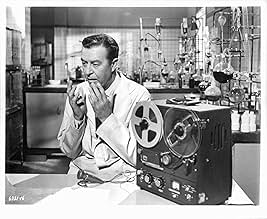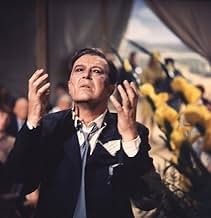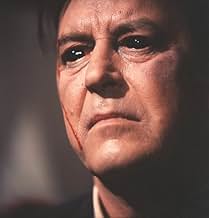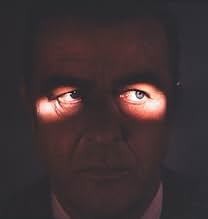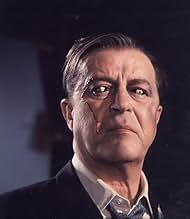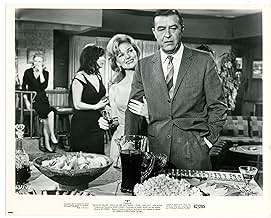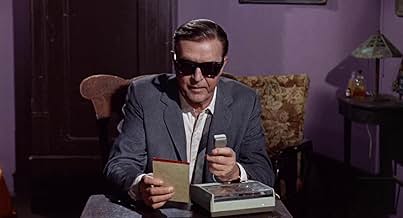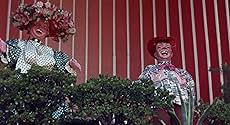IMDb-BEWERTUNG
6,6/10
8795
IHRE BEWERTUNG
Füge eine Handlung in deiner Sprache hinzuAn ambitious scientist invents an eye drop formula that grants him X-ray vision, but his new powers have disastrous consequences.An ambitious scientist invents an eye drop formula that grants him X-ray vision, but his new powers have disastrous consequences.An ambitious scientist invents an eye drop formula that grants him X-ray vision, but his new powers have disastrous consequences.
- Auszeichnungen
- 2 Nominierungen insgesamt
Diana Van der Vlis
- Dr. Diane Fairfax
- (as Diana van der Vlis)
Budd Albright
- Dance sequence
- (Nicht genannt)
Leon Alton
- Casino Patron
- (Nicht genannt)
Morris Ankrum
- Mr. Bowhead
- (Nicht genannt)
Benjie Bancroft
- Dealer
- (Nicht genannt)
George DeNormand
- Medical Board Member
- (Nicht genannt)
John Dierkes
- Preacher
- (Nicht genannt)
Bobby Gilbert
- Man Outside Office
- (Nicht genannt)
Stuart Hall
- Casino Patron
- (Nicht genannt)
Kathryn Hart
- Mrs. Mart
- (Nicht genannt)
Ed Haskett
- Casino Patron
- (Nicht genannt)
Jonathan Haze
- Heckler
- (Nicht genannt)
Harvey Jacobson
- Casino Boss
- (Nicht genannt)
Vicki Lee
- Young Girl Patient
- (Nicht genannt)
Empfohlene Bewertungen
Dr Xavier (Ray Milland) thirst of knowledge experiments with a formula on his owns eyes which will allow to see through solid material. As he can read a closed book , making diagnosis ills , and seeing naked people. He can literally observe through things , watching beyond of visible lights and turning into a rarefied figure as mad doctor. Then the staff intends to cut off his funds for further research . But an accident takes place , dieing a medic (Harlod J Stone), as he flees and the newspapers publicize , as the Angeles Daily Sun : ¨Doctor falls to death¨, ¨Physician murdered¨ and the Angeles Chronicle : ¨Doctor killer flees¨. Later on , Xavier wearing dark glasses works at a sideshow (ruled by Don Rickles) as fortune teller and finally as psychic consultant. Such increased powers of perception and knowledge bring him neither happiness nor strengthening but transform him an outcast, unsettling person.
A stylish and first-rate film , confidently realized and plenty of eye-popping moments referred to the visions. The basic opposition between blindness and vision is a central key of this interesting work. Good performances from Ray Milland as doctor who gains power to see beyond, Harold J Stone as unfortunate medic who accidentally falls and Don Rickles as ambitious manager . Appears uncredited notorious secondary cast as Morris Ankrum, John Hoyt, and John Dierkes as preacher. Furthermore unbilled actors of the Corman factory as Dick Miller and Jonathan Haze. It packs not withstanding and weak special effects made by date means. Rare musical score by Lex Baxter and colorful cinematography by Floyd Crosby, booth of whom are habitual of Roger Corman.
After his period realizing poverty-budget horror movies as ¨Swamp woman, The beast with a million of eyes, Attack of the crab monsters , Undead¨, then came the cycle of tales of terror based on Poe as ¨ House of Usher, Pit and pendulum, The raven , Tales of terror, The masque of the red death ¨ , and Corman made this undisputed masterpiece , X , that won the Golden Asteroid in the Trieste Festival of Science Fiction Films in 1963. Rating : Above average, definitively wholesome watching , Corman's achievement to have bent the Sci-Fi genre with splendid results.
A stylish and first-rate film , confidently realized and plenty of eye-popping moments referred to the visions. The basic opposition between blindness and vision is a central key of this interesting work. Good performances from Ray Milland as doctor who gains power to see beyond, Harold J Stone as unfortunate medic who accidentally falls and Don Rickles as ambitious manager . Appears uncredited notorious secondary cast as Morris Ankrum, John Hoyt, and John Dierkes as preacher. Furthermore unbilled actors of the Corman factory as Dick Miller and Jonathan Haze. It packs not withstanding and weak special effects made by date means. Rare musical score by Lex Baxter and colorful cinematography by Floyd Crosby, booth of whom are habitual of Roger Corman.
After his period realizing poverty-budget horror movies as ¨Swamp woman, The beast with a million of eyes, Attack of the crab monsters , Undead¨, then came the cycle of tales of terror based on Poe as ¨ House of Usher, Pit and pendulum, The raven , Tales of terror, The masque of the red death ¨ , and Corman made this undisputed masterpiece , X , that won the Golden Asteroid in the Trieste Festival of Science Fiction Films in 1963. Rating : Above average, definitively wholesome watching , Corman's achievement to have bent the Sci-Fi genre with splendid results.
I just (finally) saw this film a few days ago, after years of hearing about it. The screening was the final show of a three-day SF/horror film festival. After three days of films, most people were feeling a bit loopy and ready for some light entertainment. As X opened, quite a few members of the audience started treating it as an episode of Mystery Science Theater 3000, shouting out their own (generally lame) joke comments in response to the film. I was annoyed, because I'd been looking forward to this film all weekend (although, in their defense, certain lines have become unintentionally loaded in the comparatively sexually liberated 21st century).
What I found fascinating was that, by 15 minutes into the movie, all the commentary stopped. Once the film moved beyond the talky opening scenes and stilted dialog, once the story really got going, everyone was drawn into it. They actually paid attention to the movie instead of each other.
As SF cinema goes, this is definitely one of the more entertaining, thoughtful, and intelligent examples (and intelligent SF film is a dying genre). This one goes well beyond the standard mad scientist formula.
What I found fascinating was that, by 15 minutes into the movie, all the commentary stopped. Once the film moved beyond the talky opening scenes and stilted dialog, once the story really got going, everyone was drawn into it. They actually paid attention to the movie instead of each other.
As SF cinema goes, this is definitely one of the more entertaining, thoughtful, and intelligent examples (and intelligent SF film is a dying genre). This one goes well beyond the standard mad scientist formula.
Here is Corman at almost his best. Ray Milland was as good an actor as Vincent Price, and this story isn't trapped in the Poe mode of rotting flesh and dilapidated mansions. It's more in the manner of Corman's The Trip, which was made a few years later. Dr. Xavier discovers something that he can use to see through solid objects, but its effect is cumulative, and by the end of the movie he's seeing all the way to the core of reality.
Of course, he has to go on the run, and must abandon his medical career. We see him in a carnival, reading peoples' thoughts, and later teaming up with his x girlfriend and going to Vegas and seeing through the cards and winning big, and finally, escaping from the police, and as he drives through the Nevada desert, we see that he can't see a thing. Abandoning his Lincoln Continental, he stumbles into a tent revival meeting. The preacher, played by Royal Dano(?)is telling his followers to throw Satan out. Filmed by Floyd Crosby, with beautiful special effects, this is a real piece of 60's film-making by one of the masters.
Of course, he has to go on the run, and must abandon his medical career. We see him in a carnival, reading peoples' thoughts, and later teaming up with his x girlfriend and going to Vegas and seeing through the cards and winning big, and finally, escaping from the police, and as he drives through the Nevada desert, we see that he can't see a thing. Abandoning his Lincoln Continental, he stumbles into a tent revival meeting. The preacher, played by Royal Dano(?)is telling his followers to throw Satan out. Filmed by Floyd Crosby, with beautiful special effects, this is a real piece of 60's film-making by one of the masters.
RELEASED IN 1963 and directed by Roger Corman, "X: The Man with the X-Ray Eyes" chronicles events in Los Angeles when a doctor (Ray Milland) develops a formula that grants x-ray vision, which derails his career and forces him to join a carnival, using his new power to make a living. Diana Van der Vlis plays his disciple while Don Rickles is on hand as a carnival barker.
The early 60's vibe is to die for, but the beginning is rather dull. Things perk up at an adult party where the aging doctor tries to keep hip and eventually sees everyone nakkid (lol). The carnival sequence and what it leads into are arguably the best parts, although the Vegas and tent revival episodes have their attractions. The movie scores meh on the female front, but Lorrie Summers and Cathie Merchant have small parts.
THE MOVIE RUNS 1 hour 19 minutes and was shot in Los Angeles, California & Las Vegas, Nevada. WRITERS: Robert Dillon and Ray Russell. ADDITIONAL CAST: Harold J. Stone and John Hoyt play colleagues of the doctor.
GRADE: B-
The early 60's vibe is to die for, but the beginning is rather dull. Things perk up at an adult party where the aging doctor tries to keep hip and eventually sees everyone nakkid (lol). The carnival sequence and what it leads into are arguably the best parts, although the Vegas and tent revival episodes have their attractions. The movie scores meh on the female front, but Lorrie Summers and Cathie Merchant have small parts.
THE MOVIE RUNS 1 hour 19 minutes and was shot in Los Angeles, California & Las Vegas, Nevada. WRITERS: Robert Dillon and Ray Russell. ADDITIONAL CAST: Harold J. Stone and John Hoyt play colleagues of the doctor.
GRADE: B-
To this writer, the film is Roger Corman's best entry into sci-fi. Many of his 50s efforts hold a certain campy charm, with their low-budget effects - and this film is similar in that regard. It does not dwell on the effects, in fact some of them are rather poor. What it does have in its favor is a tight screenplay that gets into the story quickly, as will the viewer - and it's engrossing enough and the characters interesting enough that one stays involved through the episodic story.
What it has most in its favor is an excellent performance from Ray Milland, then in his last days being top-billed, and he milks it for all that it's worth. In some scenes Corman goes for a direct close-up and Milland's facial reactions indicate that he took the the role in a small-budget/tight schedule film with all the enthusiasm that he did in one of his roles for Alfred Hitchcock ("Dial M For Murder") or Fritz Lang ("Ministry of Fear"). Smooth, refined, but a man of immediate action if necessary, Milland's Dr. Xavier is not your usual mad scientist. As with Claude Rains in "The Invisible Man" or Al Hedison in "The Fly" he's the scientist who made the mistake of being his own subject.
Occasionally Corman goes for the cheap gag (the party sequence, where Xavier examines the guests sans attire - but inoffensive in a typical 60s approach), but the carnival scenes and the basement healer scenes show a maturity to Corman's direction, and these scenes are greatly helped by the performance of Don Rickles. He's as sleazy as one can get and admits that if he had the power, he would use it to see "all the undressed women my poor eyes can stand" and you believe it. A scene where Milland confronts other carnival workers who are speculating on his "power" shows the doctor to be both introspective and world weary at the same time. At this point even he does not know what to do with his ability, but Rickles' suggestion of setting up a site to "heal" others leads to the film's most revealing and almost poetic sequence. Xavier's original intention was to help the ill, but his implication in an accidental murder led him to seek refuge in the carnival Richard Kimble-style.
Diana Van Der Vlis does well with her underwritten role in which at one point she's rather quickly dropped, and then resurfaces rather conveniently later in the story - to no great effect. This was only her second feature film, though she had done a number of TV guest shots. Although half Milland's age, she seems more mature than her 28 years and they make a believable pair. A bonus is the appearance of a number of veterans in brief roles - John Hoyt, Harold J. Stone, John Dierkes and Morris Ankrum, as well as Corman stalwart Dick Miller. Miller shares his scenes with Jonathan Haze, whom it appears was getting the cheapest rate Corman could pay as he has no lines at all. He was rather bitter about this as he revealed in an interview years later.
Floyd Crosby's cinematography belies the small budget - only $300,000 and a shooting schedule of about three weeks. According to Corman they did rehearse a bit more than usual - and in the finished product it shows. He claims he even went as high as four takes, which may not exactly put him in William Wyler or Stanley Kubrick territory, but it's a far cry from what he'd do in the 50s. Les Baxter contributes what may be my favorite of his scores, fully complimentary to the action on screen without overwhelming it.
There's a bit of controversy over the ending - some attribute an extra line of dialog that never appeared in any print that I've seen, but it is still one of the most surprising endings of any sci-fi film since "The Incredible Shrinking Man." That it won the top prize at the Trieste Science Fiction Film Festival would be enough for one to be curious enough to see it even this many years later - that it has held up so well over 40 years points to that award's validity.
What it has most in its favor is an excellent performance from Ray Milland, then in his last days being top-billed, and he milks it for all that it's worth. In some scenes Corman goes for a direct close-up and Milland's facial reactions indicate that he took the the role in a small-budget/tight schedule film with all the enthusiasm that he did in one of his roles for Alfred Hitchcock ("Dial M For Murder") or Fritz Lang ("Ministry of Fear"). Smooth, refined, but a man of immediate action if necessary, Milland's Dr. Xavier is not your usual mad scientist. As with Claude Rains in "The Invisible Man" or Al Hedison in "The Fly" he's the scientist who made the mistake of being his own subject.
Occasionally Corman goes for the cheap gag (the party sequence, where Xavier examines the guests sans attire - but inoffensive in a typical 60s approach), but the carnival scenes and the basement healer scenes show a maturity to Corman's direction, and these scenes are greatly helped by the performance of Don Rickles. He's as sleazy as one can get and admits that if he had the power, he would use it to see "all the undressed women my poor eyes can stand" and you believe it. A scene where Milland confronts other carnival workers who are speculating on his "power" shows the doctor to be both introspective and world weary at the same time. At this point even he does not know what to do with his ability, but Rickles' suggestion of setting up a site to "heal" others leads to the film's most revealing and almost poetic sequence. Xavier's original intention was to help the ill, but his implication in an accidental murder led him to seek refuge in the carnival Richard Kimble-style.
Diana Van Der Vlis does well with her underwritten role in which at one point she's rather quickly dropped, and then resurfaces rather conveniently later in the story - to no great effect. This was only her second feature film, though she had done a number of TV guest shots. Although half Milland's age, she seems more mature than her 28 years and they make a believable pair. A bonus is the appearance of a number of veterans in brief roles - John Hoyt, Harold J. Stone, John Dierkes and Morris Ankrum, as well as Corman stalwart Dick Miller. Miller shares his scenes with Jonathan Haze, whom it appears was getting the cheapest rate Corman could pay as he has no lines at all. He was rather bitter about this as he revealed in an interview years later.
Floyd Crosby's cinematography belies the small budget - only $300,000 and a shooting schedule of about three weeks. According to Corman they did rehearse a bit more than usual - and in the finished product it shows. He claims he even went as high as four takes, which may not exactly put him in William Wyler or Stanley Kubrick territory, but it's a far cry from what he'd do in the 50s. Les Baxter contributes what may be my favorite of his scores, fully complimentary to the action on screen without overwhelming it.
There's a bit of controversy over the ending - some attribute an extra line of dialog that never appeared in any print that I've seen, but it is still one of the most surprising endings of any sci-fi film since "The Incredible Shrinking Man." That it won the top prize at the Trieste Science Fiction Film Festival would be enough for one to be curious enough to see it even this many years later - that it has held up so well over 40 years points to that award's validity.
Wusstest du schon
- WissenswertesTo create the effect of being able to see through a building, the director filmed the building while it was under construction.
- PatzerThe first X-ray that Dr. Xavier quizzes Dr. Fairfax with is a normal chest X-ray. There is no bullet on that film. Bullets show up very well on X-rays.
- Zitate
Dr. Diane Fairfax: What do you see?
Dr. James Xavier: The city... as if it were unborn. Rising into the sky with fingers of metal, limbs without flesh, girders without stone. Signs hanging without support. Wires dipping and swaying without poles. A city unborn. Flesh dissolved in an acid of light. A city of the dead.
- Alternative VersionenThrough an apparent lab error, some of the 16mm U.S. television syndication prints had the ending credits in Spanish.
- VerbindungenEdited into Gli ultimi giorni dell'umanità (2022)
Top-Auswahl
Melde dich zum Bewerten an und greife auf die Watchlist für personalisierte Empfehlungen zu.
- How long is X: The Man with the X-Ray Eyes?Powered by Alexa
Details
- Erscheinungsdatum
- Herkunftsland
- Sprache
- Auch bekannt als
- X
- Drehorte
- Queen of Angels Hospital - 2301 Bellevue Avenue, Los Angeles, Kalifornien, USA(Establishing shot of hospital.)
- Produktionsfirma
- Weitere beteiligte Unternehmen bei IMDbPro anzeigen
Box Office
- Budget
- 250.000 $ (geschätzt)
- Laufzeit1 Stunde 19 Minuten
- Sound-Mix
- Seitenverhältnis
- 1.85 : 1
Zu dieser Seite beitragen
Bearbeitung vorschlagen oder fehlenden Inhalt hinzufügen

Oberste Lücke
By what name was Der Mann mit den Röntgenaugen (1963) officially released in India in English?
Antwort

